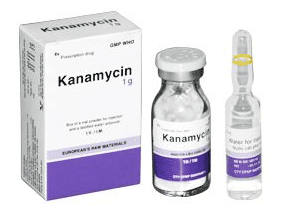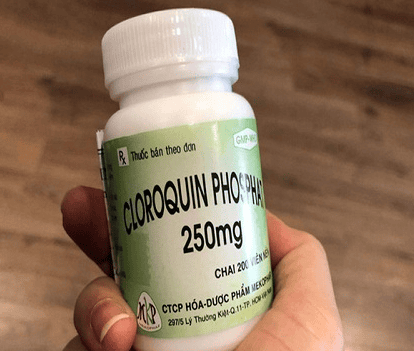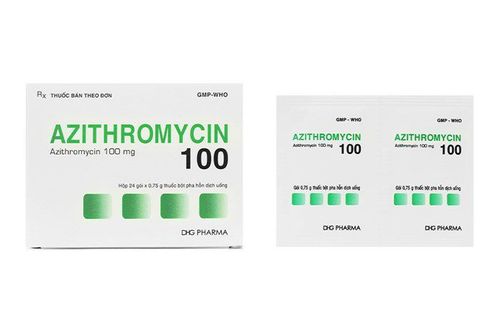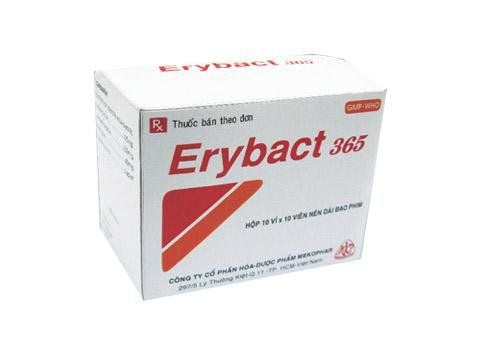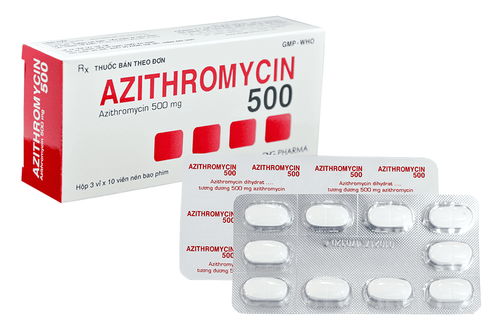This is an automatically translated article.
Azithromycin is a macrolide antibiotic with a spectrum of activity mainly against Gram-positive bacteria. This antibiotic is in Azihasan 125. So what does Azihasan 125 do?1. What is Azihasan 125?
Azihasan 125 is a product of Hasan (Vietnam) Co., Ltd., prepared in powder form for oral suspension, ingredients include:
Main active ingredients: Azithromycin dihydrate 131mg, equivalent to Azithromycin 125mg; Excipients: Saccharose, Saccharin sodium, corn starch, orange flavor, PEG 6000. Packing of Azihasan 125: Box of 6 or 30 packs, 1.5g each.
2. What are the effects of Azihasan 125?
How does Azihasan 125 work? The active ingredient Azithromycin in Azihasan 125 is a semi-synthetic Azalide antibiotic, a subgroup of Macrolides. Chemically, Azithromycin differs from Erythromycin in that the nitrogen atom is substituted with a methyl group on the lactone ring. Azihasan 125 has a strong bactericidal effect through binding to the ribosomes of pathogenic bacteria, thereby inhibiting their protein synthesis. However, Azithromycin now has cross-resistance with Erythromycin, so careful consideration should be given when using Azihasan 125 because macrolide-resistant strains of bacteria have spread in Vietnam.
Azihasan 125 is used to effectively kill some strains of Gram-positive bacteria such as Streptococcus (streptococcal), Pneumococcus (pneumococcal) and Staphylococcus aureus (Staphylococcus aureus). However, recent studies conducted in Vietnam showed that these strains were resistant to macrolide antibiotics at the rate of about 40%, thus partly limiting the use of Azihasan 125. In addition, several strains of bacteria were previously sensitive to Azithromycin, including Corynebacterium diphtheriae (which causes diphtheria), Clostridium perfringens, Peptostreptococcus and Propionibacterium acnes. It is important to note that most strains of bacteria that are resistant to Erythromycin may also be resistant to Azithromycin, including Enterococcus strains, and that most methicillin-resistant Staphylococcus is already completely resistant to Azithromycin. Azithromycin is also sensitive to some Gram-negative bacteria such as Haemophilus influenzae, Parainfluenzae, Moraxella catarrhalis, Yersinia, Legionella pneumophila, Bordetella pertussis, Neisseria gonorrhoeae and Campylobacter sp. Previously, Azithromycin had moderate activity against some Gram-negative strains such as E. coli, Salmonella enteritidis and Salmonella typhi, Enterobacter, Aeromonas hydrophila and Klebsiella. While Gram-negative strains resistant to Azithromycin include Proteus, Serratia, Pseudomonas aeruginosa and Morganella.
Pharmacokinetic characteristics of Azihasan 125:
Absorption: Azihasan 125 is rapidly absorbed with oral bioavailability of about 40%. In particular, the concentration of Azithromycin in cells is higher than in plasma, so it is used to treat good intracellular bacteria. However, the absorption of Azihasan 125 is affected by food; Distribution: Azihasan 125 is widely distributed throughout the body, mainly concentrated in the lungs, tonsils, prostate, granulocytes and macrophages... In contrast, the concentration of Azithromycin in the central nervous system is very low. ; Metabolism: A small amount of Azihasan 125 is demethylated in the liver and excreted unchanged in the bile; Elimination: Approximately 6% of an oral dose of Azihasan 125 is excreted in the urine within 72 hours as unchanged drug.
3. Indications and contraindications of Azihasan 125
Azihasan 125 is indicated for infections with bacteria sensitive to Azithromycin such as:
Lower respiratory tract infections such as pneumonia or acute bronchitis caused by Haemophilus influenzae, Moraxella catarrhalis or Streptococcus pneumoniae; Upper respiratory tract infections, including ENT region such as sinusitis, pharyngitis, tonsillitis and otitis media; Skin and soft tissue infections such as skin boils, pyoderma, impetigo caused by strains of bacteria such as Staphylococcus aureus, Streptococcus pyogenes, Streptococcus agalactiae...; Uncomplicated sexually transmitted disease in both men and women (except gonorrhea) caused by Chlamydia trachomatis or non-multiresistant Neisseria gonorrhoeae. However, because bacteria have been relatively resistant to Azithromycin, Azihasan 125 should only be used for patients with contraindications due to allergy to penicillin.
Some cases of contraindications to Azihasan 125:
Hypersensitivity to Azithromycin and macrolide antibiotics; Azihasan 125 is contraindicated with Ergotamine and Bromocriptine.
4. Dosage, how to use Azihasan 125
The recommended dose of Azihasan 125 for adults is as follows:
Upper respiratory tract infections, lower respiratory tract infections and skin and soft tissue infections: The first day take only 4 tablets of Azihasan 125 (500mg Azithromycin) on the first day. for the next 4 days, take 2 pills of Azihasan 125 1 time/day; Sexually transmitted diseases caused by Chlamydia trachomatis, Haemophilus ducreyi or Neisseria gonorrhoeae: It is recommended to take a single dose of 8 tablets of Azihasan 125 (equivalent to 1g of Azithromycin); Elderly people, patients with renal impairment or mild liver failure do not need to adjust the dose of Azihasan 125. Recommended dose of Azihasan 125 for children under 12 years old:
Method 1: Give the child a single dose of 10mg/kg/day for 3 days; Method 2: The first day use a dose of 10mg/kg once only, the next 4 days take a dose of 5mg/kg/day orally once; There is no information on the efficacy and safety of Azihasan 125 when used in children under 6 months of age. Therefore, the drug is not prescribed for this group of children. How to use Azihasan 125:
Dissolve the powder with a little warm water, stir well to dissolve completely and then drink; The best time to take the medicine is on an empty stomach, at least 1 hour before or 2 hours after eating.
5. Drug interactions of Azihasan 125
As mentioned above, food reduces the bioavailability of Azihasan 125 by 50%; Erectile dysfunction derivatives should not be used concurrently with Azihasan 125 due to the increased risk of ergot poisoning; Azihasan 125 should only be taken at least 1 hour before or 2 hours after taking stomach antacids; Digoxin, Cyclosporin: Azithromycin affects the metabolism of Digoxin and Cyclosporin. Therefore, it is necessary to monitor and adjust the dose (if necessary) when using Azihasan 125 simultaneously; Anticoagulant coumarin: Azihasan 125 can be used concurrently with Warfarin, however, the patient's blood clotting time must be monitored periodically; Rifabutin reduces neutrophils when used in combination with Azihasan 125; Theophylline: No pharmacokinetic effects have been observed when using the combination of Azihasan 125 and Theophylline. However, theophylline concentration must be monitored when combined; Carbamazepine, Cimetidine, Methylprednisolone: Azithromycin has little effect on the pharmacokinetics of these three drugs.
6. Side effects of Azihasan 125
Azihasan 125 has good tolerability, most of the side effects, if any, are mild to moderate and reversible upon discontinuation of the drug.
The most common side effect when using Azihasan 125 is gastrointestinal disorders (appears in about 10% of cases) with symptoms such as indigestion, flatulence, diarrhea, nausea, vomiting, abdominal pain, spasticity of the abdominal muscles... but usually mild and occur less frequently than Erythromycin.
In addition, reversible hearing loss has been observed in some patients receiving prolonged high doses of Azihasan 125. Very rare cases of using Azihasan 125 have taste disturbances, nephritis, vaginitis ... or neurological side effects such as headache, drowsiness, dizziness, dizziness, fatigue.. or on the skin such as rash, swelling, increased photosensitivity, peripheral angioedema...
Some patients taking Azihasan 125 have reversible hepatic transaminase elevations or liver abnormalities such as hepatitis, cholestatic jaundice.
7. Some precautions when using Azihasan 125
During the use of Azihasan 125, patients should pay attention to the following:It is necessary to adjust the dose of Azihasan 125 appropriately in patients with liver or kidney failure (creatinine clearance less than 40 ml/min). ). Caution should be exercised against the risk of superinfection with non-susceptible organisms and pseudomembranous colitis when broad-spectrum antibiotics such as Azithromycin are used. Caution because Azihasan 125 has the potential to cause allergic reactions such as angioedema and anaphylaxis (although very rare). There are no data on the use of Azihasan 125 in pregnant or lactating women. Therefore, Azihasan 125 should only be used when no other suitable antibiotic is available. Azithromycin's ability to be excreted in human milk is unknown, so it should be used with caution. Azihasan 125 is a semi-synthetic Azalide antibiotic, a subgroup of Macrolides. Azihasan 125 is indicated for infections caused by bacteria sensitive to Azithromycin. To ensure the effectiveness of treatment and avoid unwanted side effects, patients need to strictly follow the instructions of the doctor, professional pharmacist.
Follow Vinmec International General Hospital website to get more health, nutrition and beauty information to protect the health of yourself and your loved ones in your family.
Please dial HOTLINE for more information or register for an appointment HERE. Download MyVinmec app to make appointments faster and to manage your bookings easily.




